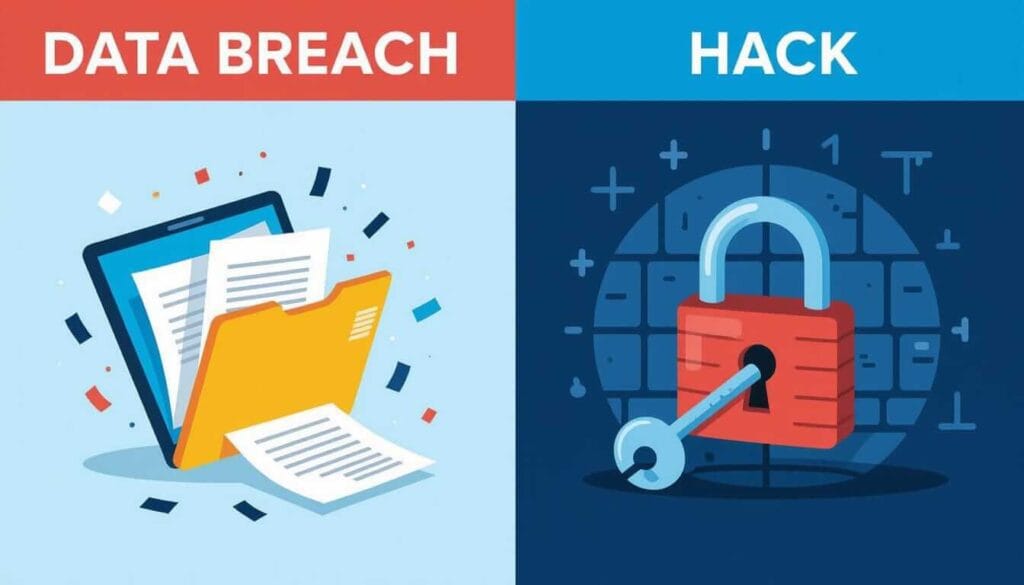When people talk about data breaches and hacking, the terms often get mixed up.
Understanding the difference is essential for protecting personal information. In our connected world, knowing what sets a data breach apart from a hack can help you recognize risks and take steps to guard your accounts.

Being aware of these threats matters because cybercrime statistics keep rising. Apple reported that in only two years, there had been 2.6 billion data breaches of personal records. If you are curious as to how the threats have changed in recent years, let’s look at what makes each type unique, and why your understanding makes a difference.
A data breach happens when sensitive data, such as login credentials or financial information, is leaked or accessed without permission. Unlike hacking, a breach can be the result of mistakes, weak website security, or even somebody losing a device (like an unencrypted laptop). A key thing to remember is that not all data breaches need to involve a deliberate cyberattack.
For example, in 2023, MOVEit, a popular file transfer tool, was involved in a major breach due to a software vulnerability. Attackers exploited this weakness and stole huge amounts of data from government agencies and companies worldwide. The breach affected over 600 organizations and exposed personal information from at least 40 million people.
Many breaches are discovered much later, sometimes months after the data gets out. This delay can make things worse for people whose data was leaked. IT teams often have to comb through logs and system records to figure out what went wrong.

A hack usually means that a person or group actively broke into a system by defeating defences. Hacking means using clever techniques or tools to get around security rules set by software or network administrators. It’s like a burglar picking a lock or finding a way through a hidden door instead of stumbling on it by accident.
For instance, in December 2020, the SolarWinds supply chain hack shook the world’s biggest companies and government agencies. Hackers inserted malicious code into software updates, allowing access to sensitive networks, including major American and Canadian organizations. The U.S. government estimated that the hackers had access for around nine months before being discovered.
Another striking example was the Colonial Pipeline ransomware hack in 2021, which temporarily shut down a critical oil supply route in the United States, pushing up gas prices and causing shortages. This hack showed how cybercriminals could paralyze physical infrastructure, not just steal personal details.
Both data breaches and hacks commonly target weak spots such as outdated server software or companies that fail to patch security holes. Still, while all hacks can cause data breaches, not all breaches are caused by hacking.

Knowing the threat is only half the battle; taking simple action is even more important. At Tresseo, we suggest using strong, unique passwords for each online account. Imagine each password like a different key for every door in your house. When available, always turn on two-factor authentication (2FA). This method acts as a second lock, making it nearly impossible for a thief to get in with just your password.
Keeping your devices and apps updated is also essential. Hackers often target old and unpatched systems. Think of these updates as regular maintenance. Just like a mechanic checks your car to keep it running safely. Ignore those reminders, and you might leave a window open for someone to climb through.
If you run a blog, small business, or website, proper web hosting and regular backups are vital. A reputable web host monitors for intrusions and provides tools to limit access through firewall settings. In the event of a breach, regular backups let you restore your website to a safe state. It’s almost like having a spare copy of important files in a safety deposit box, in case something happens.
It’s smart to limit the number of people with access to sensitive data or site controls. The fewer keys handed out, the less likely someone will misuse them or lose them. Make sure every administrator uses strong passwords and 2FA, and review access lists often.
Next, remember to stay alert to phishing and social engineering tricks. Even the most secure systems can fall if a clever attacker fools an employee into handing over credentials.
Understanding the difference between data breaches and hacking helps you spot both accidental leaks and deliberate attacks.
By keeping devices patched, using strong passwords, and learning about online scams, you can lower your risk and keep your information protected. Cybersecurity isn’t just for IT experts. Everyone has a role in keeping data safe. At Tresseo, we believe that good habits can make a real difference. Stay curious and proactive; a little extra care today can prevent major problems in the future.




Copyright © 2022 - 2025. Tresseo. All rights reserved.